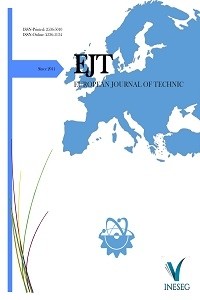Increasing The Tensile Strength of Adhesive T-Type Joints with Bio-Inspired 3D Printed Inserts
Increasing The Tensile Strength of Adhesive T-Type Joints with Bio-Inspired 3D Printed Inserts
Adhesives, T-type Joint, Additive Manufacturing 3D Printing, Tensil Test,
___
- [1] U. A. Khashaba, T. A. Sebaey, and A. I. Selmy, “Experimental verification of a progressive damage model for composite pinned-joints with different clearances,” International Journal of Mechanical Sciences, vol. 152, pp. 481–491, Mar. 2019, doi: 10.1016/j.ijmecsci.2019.01.023.
- [2] A. A. Abd-Elhady, S. Mousa, W. H. Alhazmi, H. E. M. Sallam, and M. Atta, “Effects of composite patching on cyclic crack tip deformation of cracked pinned metallic joints,” Journal of Adhesion, vol. 97, no. 16, pp. 1561–1577, 2021, doi: 10.1080/00218464.2020.1803843.
- [3] E. Çetkin, Y. H. Çelik, and Ş. Temiz, “Effect of welding parameters on microstructure and mechanical properties of AA7075/AA5182 alloys joined by TIG and MIG welding methods,” Journal of the Brazilian Society of Mechanical Sciences and Engineering, vol. 42, no. 1, Jan. 2020, doi: 10.1007/s40430-019-2119-7.
- [4] J. P. A. Valente, R. D. S. G. Campilho, E. A. S. Marques, J. J. M. Machado, and L. F. M. da Silva, “Geometrical optimization of adhesive joints under tensile impact loads using cohesive zone modelling,” International Journal of Adhesion and Adhesives, vol. 97, Mar. 2020, doi: 10.1016/j.ijadhadh.2019.102492.
- [5] M. A. Morgado, R. J. C. Carbas, E. A. S. Marques, and L. F. M. da Silva, “Reinforcement of CFRP single lap joints using metal laminates,” Composite Structures, vol. 230, no. September, p. 111492, 2019, doi: 10.1016/j.compstruct.2019.111492.
- [6] Ş. Temiz, “Application of bi-adhesive in double-strap joints subjected to bending moment,” Journal of Adhesion Science and Technology, vol. 20, no. 14, pp. 1547–1560, 2006, doi: 10.1163/156856106778884262.
- [7] B. Bahrami, M. R. Ayatollahi, M. J. Beigrezaee, and L. F. M. da Silva, “Strength improvement in single lap adhesive joints by notching the adherends,” International Journal of Adhesion and Adhesives, vol. 95, no. June, p. 102401, 2019, doi: 10.1016/j.ijadhadh.2019.102401.
- [8] S. M. R. Khalili, A. Ghaznavi, and A. Ghaznavi, “Effect of joint geometry on the behavior and failure modes of sandwich T-joints under transverse static and dynamic loads,” Journal of Adhesion, vol. 91, no. 3, pp. 154–176, Mar. 2015, doi: 10.1080/00218464.2013.855881.
- [9] M. Y. Solmaz and T. Topkaya, “Progressive failure analysis in adhesively, riveted, and hybrid bonded double-lap joints,” Journal of Adhesion, vol. 89, no. 11, 2013, doi: 10.1080/00218464.2013.765800.
- [10] A. Rudawska, “Selected aspects of the effect of mechanical treatment on surface roughness and adhesive joint strength of steel sheets,” International Journal of Adhesion and Adhesives, vol. 50, pp. 235–243, Apr. 2014, doi: 10.1016/j.ijadhadh.2014.01.032.
- [11] E. G. Baburaj, D. Starikov, J. Evans, G. A. Shafeev, and A. Bensaoula, “Enhancement of adhesive joint strength by laser surface modification,” International Journal of Adhesion and Adhesives, vol. 27, no. 4, pp. 268–276, Jun. 2007, doi: 10.1016/j.ijadhadh.2006.05.004.
- [12] J. v. Cardoso, P. v. Gamboa, and A. P. Silva, “Effect of surface pre-treatment on the behaviour of adhesively-bonded CFRP T-joints,” Engineering Failure Analysis, vol. 104, no. June, pp. 1188–1202, 2019, doi: 10.1016/j.engfailanal.2019.05.043.
- [13] İ. Saraç, H. Adin, and Ş. Temiz, “A research on the fatigue strength of the single-lap joint joints bonded with nanoparticle-reinforced adhesive,” Welding in the World, vol. 65, pp. 635–642, 2021, doi: 10.1007/s40194-020-01063-2/Published.
- [14] E. Çetkin, “Determination of the effects of GNP and nano-fibers on bonding joints,” Journal of Manufacturing Processes, vol. 71, pp. 27–36, Nov. 2021, doi: 10.1016/j.jmapro.2021.09.013.
- [15] R. Gholami, H. Khoramishad, and L. F. M. da Silva, “Glass fiber-reinforced polymer nanocomposite adhesive joints reinforced with aligned carbon nanofillers,” Composite Structures, vol. 253, no. July, p. 112814, 2020, doi: 10.1016/j.compstruct.2020.112814.
- [16] S. Akpinar, M. D. Aydin, Ş. Temiz, and A. Özel, “3-D non-linear stress analysis on the adhesively bonded T-joints with embedded supports,” Composites Part B: Engineering, vol. 53, pp. 314–323, Oct. 2013, doi: 10.1016/j.compositesb.2013.04.049.
- [17] R. Akrami, S. Fotouhi, M. Fotouhi, M. Bodaghi, J. Clamp, and A. Bolouri, “High-performance bio-inspired composite T-joints,” Composites Science and Technology, vol. 184, no. September, p. 107840, 2019, doi: 10.1016/j.compscitech.2019.107840.
- [18] L. A. Burns, A. P. Mouritz, D. Pook, and S. Feih, “Strength improvement to composite T-joints under bending through bio-inspired design,” Composites Part A: Applied Science and Manufacturing, vol. 43, no. 11, pp. 1971–1980, 2012, doi: 10.1016/j.compositesa.2012.06.017.
- [19] M. Barzegar, M. D. Moallem, and M. Mokhtari, “Progressive damage analysis of an adhesively bonded composite T-joint under bending, considering micro-scale effects of fiber volume fraction of adherends,” Composite Structures, vol. 258, Feb. 2021, doi: 10.1016/j.compstruct.2020.113374.
- [20] M. Y. Solmaz and T. Topkaya, “The flexural fatigue behavior of honeycomb sandwich composites following low velocity impacts,” Applied Sciences (Switzerland), vol. 10, no. 20, 2020, doi: 10.3390/app10207262.
- [21] İ. Saraç, H. Adin, and Ş. Temiz, “Experimental determination of the static and fatigue strength of the adhesive joints bonded by epoxy adhesive including different particles,” Composites Part B: Engineering, vol. 155, no. July, pp. 92–103, 2018, doi: 10.1016/j.compositesb.2018.08.006.
- ISSN: 2536-5010
- Yayın Aralığı: Yılda 2 Sayı
- Başlangıç: 2011
- Yayıncı: Hibetullah KILIÇ
Investigation of Static and Dynamic Analysis of Asynchronous Motors in the Cement Industry
Hayrullah Çağtay ALKAYA, Sertaç GÖRGÜLÜ
Teaching Algorithms Design Approaches via Interactive Jupyter Notebooks
Increasing The Tensile Strength of Adhesive T-Type Joints with Bio-Inspired 3D Printed Inserts
Mirari Ğunav GEÇİT, Tolga TOPKAYA
Q-Learning Based Obstacle Avoidance Data Harvesting Model Using UAV and UGV
İsmail Ümit ÇIKMAN, Mehmet Emin ÖNCÜ, Şermin KOÇYİĞİT
Determination of Antioxidant Activity of Dietary Selenium, Oleuropein, Glutathione Mixture
Efficiency Analysis in Solar Air Heaters with Attached Internal Fins
